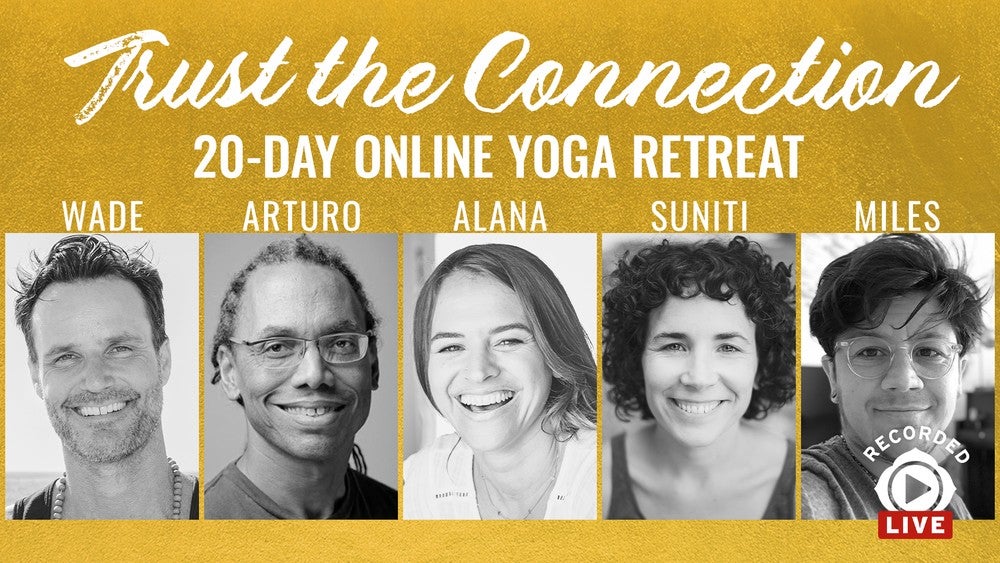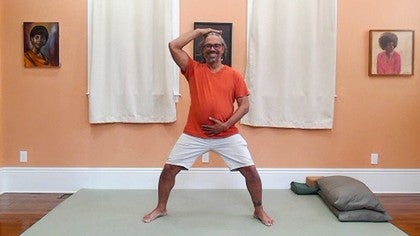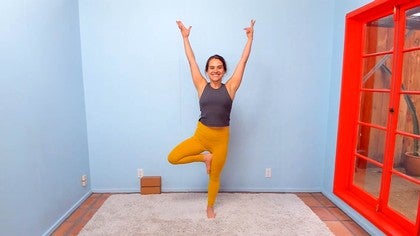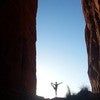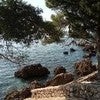Description
About This Video
Transcript
Read Full Transcript
Hey, everyone. Welcome back to Trust the Connection, day 17 of our online retreat. Today's my last day teaching. I've been having a great time. I've really been enjoying myself and I hope you've been enjoying the practices with all of these amazing teachers. It's been so great to hook into the community and work with this amazing team of teachers and the amazing folks that you don't get to see who are backstage, so to speak, who are running the show. Thank you so much. Today's practice, you'll need a couple of bed pillows, two bed pillows, one towel or blanket, and a yoga block. And we're going to start off standing. We're going to focus on nourishing our yin energy, which is the energy at the bottom of the valley, the really rich nourishing energy or the energy of the deep ocean, which is really rich and nourishing, as opposed to the yang energy that's really active. And this is more the energy of stillness. We're going to start with a wide stance, toes turned a little bit out and bend into the knees. Now, when you bend into the knees, make sure that you're not tucking your tailbone forward, but stick your booty out just a little bit so you have a little arch in your low back. Slight arch in the low back. Relax your shoulders. Should feel your quads working, but if your knees are hurting, come up a little bit. We don't want to feel knee pain, but we do want to feel quads working, the thigh muscles working. And then floating the arms up, head first to about heart heights, fingertips facing each other and the palms facing your heart. I heard, I think it was Siniti called this goddess pose. And while in martial arts we often call it a horse stance, I like goddess pose. I can get in touch with my inner goddess because we all got our goddess size. As you're holding your arms here, facing each other, your shoulders might get a little tired. You can let them rest. If your legs get tired, good. That means you're doing it right. You can try coming down a little deeper. You can try breathing. Coming down a little deeper actually doesn't decrease the work on the quads, but when you come back up to where you were, it seems so much easier. And actually if you get tired and need a little break, stand straight and shake your quads at any time and then sink back in a little bit of sticking the booty out. Connecting with this earth energy, blow us. And we're going to take the hands and using the hands, using our intention because energy will follow intention. We're going to breathe open our lowest chakras, our first and second chakras. Inhale and exhale the hands back towards the hara, the tan tien, the center, the low center. Inhale opening. Inhale drawing in towards the center. And we want to have the image of drawing this rich wisdom, this rich basis, this rich earth knowledge into our low center. Inhale. You can sink a little and draw it into your hearts, into your low center. Inhale. Let's exhale go a little lower. Let's inhale come back up and draw it into the center. Whoa. Inhale open. Open front, back, side, side. Exhale sink. Inhale draw it into our low center and then stand the legs and say thank you quads. Thank you. We're not done with you, but thank you. Going to do a little more. Come back into that goddess stance, horse stance. This time we're going to focus a little bit on the middle hara, the middle center which could be combined between the solar plexus and the heart chakras. So the earth center is all about connecting to our own sense of safety, knowing we're safe right here, right now supported by the earth and very safe. This middle center is about community, about connecting to others and connecting to the nutrients both of food but also the nutrient of community. So let's do the same hands here and inhale spread wide. You can keep a little low. Exhale. Draw it back in solar plexus heart area. Inhale. It's almost like can you feel our friends in Indonesia there you are. Can you feel our friends in the UK, in Florida, in Louisiana, everyone around the world connecting through this middle center, our middle hara so to speak and draw that back in towards our heart. There are a lot of disciplines that talk about illusions and the big illusion that is often perpetuated is the illusion of separation, the illusion that we're separate little beings in our own little pods. And so much of society is developed to enhance those illusions like sitting in our cars by ourselves on the freeway. We do a lot of things that are very isolating. But if we take the time to reach out, to connect, there's Suniti. Hi. Hi, Kira. Alana. And the folks whose names I don't know. But we're all connected. And draw that sense of connection into your physical layers. Expanding out. How wide can you go with this worldwide hug? And drop back in towards the physical layers.
You can do this with the legs straight if your quads are screaming at you. Maybe you want to come down and come back up. Whatever feels good for you. Connected. And we're going to shift our focus. I'm going to straighten my legs a little bit. Give them a little rest. And shift our focus up into the upper chakras. The third eye and crown, which is about universal connection. So we'll do the same thing. I'm coming into a little horse dance. If your legs are tired of it, that's all right. And I'm going to open to that universal energy with this upper center. This upper tan chien. This upper hara. And I'm getting a real strong connection with my ancestors here. A lot of times I think of ancestors as being a root thing. But I'm feeling my mom, my dad, my Uncle Aubrey, my Aunt Peg, and all those ancestors that I never got to meet. All those ancestors who got me here. And I can connect with them. And give them the gratitude that I feel. Express the gratitude towards them. Breathing. Sinking as low or as high as feels good. And then lowering your hands down. Standing up straight. Giving your quads a little thank you. That illusion of separation. We also do that in our own bodies. Because we're taught things in little boxes, we tend to keep things in little boxes. This low center is not separate from the middle center. It's not separate from the upper center. We just attach those words like chakras or meridians to be able to start to understand and digest. But really, it's all connected. Everything is absolutely connected. So let's inhale the hands out and up. And then exhale the hands down. Feeling the connections from down into the earth. Out into the world. And up into the universe. Which reconnects down into the earth. Out into our world. And expands beyond our world.
Expands beyond those labels of convenience. Because our earth is not separate from our community. Is not separate from the universe. Is not separate from us. One thing I love about science, because I'm kind of a science buff, is when Neil deGrasse Tyson said we are all stardust. Everything, everything is stardust. Everything. Us. All of this. We're all the same stuff. I am getting warm. One more. Big expansive. And then placing one hand over the heart center. Heart solar plexus center. One hand over the tan tien. Or the hara. Maybe you want to float one hand up to the crown. And one hand to the heart or the hara. I feel like I'm doing a little bit of an energetic spiritual macarena right now. If you're sinking your center, straighten your legs slightly. Turn your toes forward. Place your hands to your sides. And let's come down slowly to the mat. Now, if you have flexible hamstrings, go ahead. You can just sit on the edge of a blanket for support underneath your pelvis. I have very tight or stable hamstrings. I definitely prefer the term stable. So I'm going to make a little throne and sit up on my throne. And then I want my pillows within easy reach. We're going to come into dragonfly. Wide-legged forward fold. And notice if your knees are going straight here. We want the knees a little bent. So take a pillow. And I'm going to kind of, since I'm up on a high throne, I need a little bit more height underneath my knees. I want my knees just a little bent. Doing the forward fold with the legs completely straight. Oftentimes you'll feel the stretch just in kind of the tendon ends like up at the sitz bone and down towards the back of the knee. With the knee slightly flexed, you'll tend to feel it more the whole length of the muscle. So as you get set here, check out what your low back is doing. If your low back is rounding out behind you, try bending your knees a little higher. You might need to scoonch the pillow up so your knees are a little more bent. We want the feeling of a slight arch in the low back.
So for some of us, sitting here with our hands on the floor or on, you may even need to bring another support under to lift the heart and get a slight arch in the low back, there you might start to feel the hamstring stretch. For those of us who are very stable. We want to keep that slight arch in the hamstrings. And if you're able to slight arch in the hamstrings, slight arch in the lumbar spine as we start to tilt forward. So I don't want to round. I can round and come way forward and not feel anything in my back, but I'd rather you explore is keeping that little arch, that little arch in the low back, sticking your booty out and tilting forward. And as you tilt forward, you'll get to a place where you start to feel it in your hamstrings. For some of us, it's going to be up high. For some of you, you're going to have your chest all the way to the floor with your low back arched. Bravo. Wherever you are is right for you. We're not trying to meet some external goal. We're really going for our own sensation. I always look at that beautiful poster of Dharma Mitra, doing all the amazing yoga poses and incredible poses. And oftentimes that's used as an external goal, something to get to, something to strive for. What I'd like to invite you to do is to make your own internal yoga poster and you're the star of it. So when you find your perfect stretch, oh, this is where I want the photo of this pose taken for today. It's going to be different on different days. So we want to feel a mild to moderate stretch in the hamstrings on the backs of the thighs. You may even feel it on the inner thighs, the adductors, and keep that feeling of length in the spine, length in the neck. And we're going to hang out here for a nice long while. Stretching the fascia, going for a mild to moderate amount of stretchiness helps us focus on the connective tissue. And connective tissue is very slow to change. It's kind of like taffy. You know, like a big hunk. I don't know if they still make big hunks. But like saltwater taffy, when it's cold, if you have a bar of taffy and you try to bend it when it's cold, it will often snap. But if you take that cold bar of taffy and put it between your hands and massage it, rub it, just kind of hold it and warm it for a while, it will start to gradually get more and more pliable. Same thing with our bodies will gradually get more and more pliable. And I can already feel that my hamstrings are lengthening. It's nothing quick. It's kind of like glacier speed. So when I do like a yin type of practice, I'm staying in poses for a minimum of three minutes and oftentimes 10 to 15 minutes in a pose, especially as I've been getting up into my 60s, the connective tissue as we age, the connective tissue tends to get a little dried out. It's a little like shrink wrap, right? And if we're sitting in a particular position for a long time, that connective tissue will continue to shrink wrap. You see it when you look at a musician who's playing the guitar and holding the guitar in one position for hours upon hours upon hours and years upon years. When they put the instrument down, their body is still holding the instrument. Same thing's happening for laptop asana, sitting with our head forward and the shoulders rounded forward. When we get up from that, we're still, our connective tissue is starting to mold into that position. So one way to change that is low intensity, long duration stretches. You can go ahead and let your chin drop towards your chest. Oh, are you breathing? Always a good idea. Maybe your hands want to walk out another quarter inch. Maybe not. Are you still breathing? And what is the quality of your breath? Remember, if you're breathing like this, you can ease off a little bit. You can start to let the back round a little bit here. As you'll notice is the back rounds, it probably won't change the sensation in your legs much, but I want to keep that sensation in the legs. Oh my, oh my goodness. Let's take five more slow, deep breaths. Melting into this shape, letting that taffy that is our hamstrings. And now with the rounding, getting the part of the hamstring fascia that connects into the back muscles, that's continuous fascia, continuous connective tissue, letting that all gradually melt and get just a little bit longer. And notice if you're clenching your jaw. And we can slowly start to walk our hands back in, slowly coming up to find our way to seated, coming out of a long held pose. You want to go really gradually. You don't want to just jump up. You can help your knees bend. Bring the legs out straight, give them a little shake. I'm going to come down off my throne and I'm setting my pillows to the side here because I might need them later.
And I will need my block. I'm going to turn sideways for this. And I'm going to bring my block on the medium height setting. So not the tallest, not the shortest, but the medium height setting. And we're going to do a little self-massage. I'm going to take my right leg and place it on top of the block and then scoot a little bit. So I tip the block onto its edge. And that also means that the edge of the block is going into my calf. Now I'm starting a little towards my ankle. And then I'm just going to try to keep my foot relaxed while I roll a little side to side. If you're not getting enough pressure and the pressure at most should give you that good achy sensation, you can try adding more pressure. But if that's too much, don't do it. Just stay with the leg on there. Gradually rolling. You find an especially juicy spot. Try staying there and very slightly lifting the toes and foot. And then very slowly pointing. And then I'm going to let the block come back flat. I'm going to just take a pause. We're not done with that leg. And I'm going to scoot a little bit so that the block, the next time I tip it, comes a little bit higher. Or if you started high towards the back of the knee, that it comes a little lower. And again, I might need to adjust to find, oh, there we go. That's special. Find just the right height. I might need to add just a little bit of pressure. Notice your breathing. Moaning and groaning is absolutely allowed. Sometimes when I practice here in yoga at home, I'll play the Tibetan monks chanting because their chanting is about the same tempo as a fascia as the connective tissue release. Plus, it also inspires me to moan and groan. Oh, take a little break. And if being on your hands doesn't work for you, you can come back onto your elbows. I'm going to scoot a little closer, or you can even come onto your back. If you have a shoulder injury, for example, I'm going to tip the block a little bit. Find my third height, my third band of height. That was a lot on my wrist. This is much better on my wrist. I don't know if it's better on my calf. The calf muscles work so much for us. Thousands upon thousands of reps, overworked, under left. Oh, I found a really special spot. I'm going to lift my toes oh so slowly and stretch it underneath that pressure and then point oh so slowly. Okay. And then relax completely. And if you can't go out for getting a massage, doing things like this with a block or getting a tennis or lacrosse ball, you can do lots of great work on yourself. Okay. Then I'm going to release. Relax the leg. Lift the toes. Give the calf a little stretch. Wow. Then I'm going to switch to the other side.
So I started low. I'm going to start high this time. There's no rhyme or reason you don't have to start low on the calf. You can start up high. Let's see if I can find a special spot and sometimes I have to shift and search a little bit. Oh, there we go. Oh, my goodness. Rolling a little side to side. Just enough pressure. If the edge is too much pressure, you can let the block flatten slightly so it's not so much the edge. It's a flatter surface. We do that in body work, too. A pointy surface, it's like stilts going through layers of snow. But if you want something that doesn't go so deep, you use a broader surface like your whole hand, like snowshoes, that stays more on the top. Rolling a little, and this spot is so special, I'm going to do a little lifting and pointing. Oh, yeah. Lifting, pointing. And then I'm going to take a little break from that. Breaks are just as important because the breaks from the pressure allow blood to flow back in. And the blood returning is really important. We're pushing blood out with the pressure of the block or the pressure of your massage therapist thumb or elbow. And when they release the pressure, blood comes flowing back in, cleansing, washing away. Oh, inflammatory products that may be stuck there. And I got a really great point right here. Lifting and pointing. Rolling. Oh, my goodness gracious. And breathing. So I'm taking about the amount of time where it takes me to take five to ten really slow breaths on each point or each height of points. And then giving a little rest. I can stretch my calf and shake. And then I'm going to scoot the block a little lower. Third time's the charm coming a little closer to the ankle. And wow, there is something very special underneath this pressure. Oftentimes with bodywork or with this kind of self bodywork, it can be surprising how much juiciness, how many trigger points, how many knots are hidden in the calves. I'm going to try to roll a little side to side. And it's a little much. So I'm going to flatten the block a little bit. There we go. There we go. It's so tight on this left side for me. Still breathing. I want to go to that moderate amount of sensation.
I don't want to bruise myself. And I certainly could with one of these cork or if you have a bamboo block, you certainly could. I'm going to lift the toes and point the toes and relax. And then taking weight off the block, I'm going to scoot the block to the side. I'm going to stretch my calves by lifting the toes, pointing them, shake them out on both sides. And then staying on your back, I'm just going to scoot some of my stuff out of the way. Staying on your back, have one pillow up at your head end in case you need it. And as long as we're sitting up, just sit up and take a wide leg forward fold without anything under your booty. So your hands may be back here. And notice if your hamstrings have changed. When I do my calves, I always feel like my hamstrings gain a couple of inches. Well, I wish. Because the calf fascia is connected to the hamstring fascia. So I'm going to take one blanket behind my head or the towel behind my head for a little support. I'm going to come on to my back. I'm going to raise my arms up overhead and bring them down to the floor. And if coming this far up is uncomfortable for the shoulders, bring the pillow in and bring your arms onto the pillow. Okay, so with or without the pillow, whatever is most comfortable. Then from here, I'm going to take my heels and baby step my heels over to the right. I'm keeping my body flat on the mat. But I'm walking my heels to the right. So my pelvis kind of swings, my tailbone swings over to the right. And I feel a little stretch on the left side of my low back. And I'm going to take my hands, my head, my heart, and I'm going to go over to the right with my hands, head and heart. So I'm making a letter C shape with my body. Now this may be where I hang out. This may be it. But for some of you, you may want to take your left ankle and cross it over the right ankle. Some of you may want to take the right hand and take a hold of the left wrist and give a gentle traction. We're going for a lengthening sensation through the whole left side of the body. The left IT band on the lateral thigh, the left gluteus medius and minimus, which are right at the side of the hip. The left low back getting in particular into that quadratus lumborum between the lower ribs and the top of the pelvis. And then the intercostal muscles also up into the left shoulder. So we're going to stay here for a while. Again, we want that mild to moderate stretchy sensation, something that we can stay in, something we can hang out in, something we can melt in for at least a couple of minutes.
Still breathing. Still relaxing the corrugator super cilia, that muscle in between the eyebrows. And maybe remembering what it's like to soften the jaw, if you remember that from last week. And as you melt into the shape, eventually the fascia will lengthen. So as you're here about a minute or two, you may feel like I'm not feeling the stretch anymore. And if that's the case, you got two choices. You can stay where you're just melting into that same shape. Or you can take a little tiny ooch more. And an ooch is a very specific unit of measurement. That's a tiny, tiny bit. I'm going to stay here for about another minute, lengthening that whole left side. Meridian wise, we're really getting into the gallbladder meridian, which is part of the wood element in Chinese medicine. It's paired with the liver meridian, the liver being the yin organ and the gallbladder being the yang organ, or the liver being the solid dense organ and the gallbladder being the hollow organ. And gallbladder and liver stagnation often manifests emotionally as feelings of frustration or depression. And we want movement. And this is a nice way to gradually move. So releasing this pose, we're going to uncross if you cross them over. Baby step the heels back to center, nice and slow.
Sweep the hands, head and heart back to center and bring your hands down along your sides. And just pause here for a moment. And notice if your left side is feeling different from your right side. This is one of my favorite poses. I love this pose. I need this pose. And sweeping the hands up overhead again, baby stepping the heels over to the left, sweeping the hands, head and heart over to the left. So we're getting the gallbladder meridian on our right side. And you may want to take the right leg and cross at the right ankle over the left ankle or not. You may want to take the left hand and take a hold of the right wrist if that feels good. Going for that lengthening sensation through the whole right side of the body. IT band, gluteus medius and minimus, quadratus lumborum, the lateral abdominal muscles into these little muscles in between the ribs, the intercostals and all those shoulder muscles, 17 shoulder muscles that are attaching to the scapula, to the shoulder blade. And breathe. We're going to stay here for a little bit. Melting into the pose, breathing into the pose. Notice if the pose is bringing up emotions of frustration. It's very common when you're accessing the liver and gallbladder meridians. So you may want to explore letting those emotions move, letting your breath move them, letting sound move them. One of the sounds associated with liver cheese stagnation is a hiss, which always reminds me of the sound when you're boiling water and the pressure is building up and that's kind of what liver cheese stagnation is like. So you can try hissing and let some of that move. If you practice this on your own make sure you use a timer so that you do the same amount on each side. Make sure the alarm is set to an audible place. I fell asleep doing this on one side for 45 minutes and I had to do the other side equally. You want to do both sides equally or you're going to end up with an unpleasant limp. So you're releasing the fascia fairly equally on both sides of body, releasing the emotions equally on both sides of the body and moving the energy fairly equally on both sides of the body. Another couple of breaths here. And if you had the leg crossed over uncross and baby step the heels back to center, sweep the hands, head and heart back to center and release your arms down to your sides. And pause here. If your low back is uncomfortable with the legs straight, you can bend the knees, come into constructive rest pose with the feet a little wide and the inner knees resting into each other and take a few slow breaths. And rolling to your side, pausing on your side with just a breath or so, knees up towards your chest. You can fold up that head support a little higher so your neck is in line with the rest of your spine. And then let your head stay heavy. Roll a little forward, let your chin drop towards your chest and slowly come up to seated. Your head's the last thing to come up. And once you're up, let's take those pillows, I'm going to turn these into leg supports. So soon, Shavasana is happening.
And this towel is going to be, or your blanket can be a head support if you like it. But I'm going to do a cruel thing and make everybody come up to standing again. There's no rush to get there. We're going to come back to standing and back to a gentle goddess pose or horse stance, sinking into the hara, dropping the center towards the earth and letting this be our solid base. And then take the arms. And I'd like you to just explore the energies that you'd like to explore. And notice if you feel anything different in how your body, mind, energies are moving. I like to think of the pelvis and the sacrum kind of as the flower pot for the spine. So just explore. Maybe you're thinking about this energy of the solar plexus and heart chakra and reaching to your community. Maybe you're connecting that with the universal chakra or the earth chakra. Maybe you're just feeling it and not worried about what chakra is, who is what. And maybe you're moaning and groaning as you're playing with some movement. Find what feels super yummy for you. And eventually finding your way back to standing, somewhat straight, shoulders somewhat soft. And finding your way back down to the ground. Bring your legs so they're spaced or the pillows are going to be just about underneath your knees, your head pillow just underneath your head and neck, but not underneath your shoulders. And before we go all the way into Shavasana, let's bring one knee at a time up towards the chest, arms out to the side. I have to cactus my arms cause of my space here, but if your arms go straight out, that's fine. Inhale, exhale, take both your knees over towards one side. You can roll your nose the opposite direction of your knees and a few breaths in this pose. You might be having some physical sensations. Oh, this reminds me of that side stretch. I'm feeling my QL and my intercostals here. One more breath. Next inhale, bring your knees to the center, nose to the center. Exhale to the B side and the other side. And you may have to scooch and wiggle to find your perfect twist. Nose can go the opposite direction of your knees. Couple of breaths here. And inhaling your knees to the center, your nose to the center. Exhaling your legs out over the pillows, scooch them so they feel just right. Maybe shimmy rock your hips a little bit so you can completely relax into the earth and take about three breaths. Here, deep belly breaths. With each exhale, surrender a little more into the earth. Letting your eyes soften, letting your jaw melt. Eventually, letting go of the effort of your breath. And just rest. Trusting the natural rhythm of your breath to move in and out across your body. Like the tide moving in and out across the beach. Just rest. Just rest. Exhale to the center, exhale to the center. Exhale to the center. Exhale to the center.
And you're welcome to stay in the final relaxation as long as you like. And if you'd like to come up, you can deepen your breath again. Use that breath to expand the energy out into the toes and fingers, bringing a little movement. And bending one knee up at a time. And as you're ready, rolling slowly onto one side. From your side. And press your way up slowly. Lean up to find a comfortable seated position. Thank you so much. Namaste.
Trust the Connection: 20-Day Yoga Retreat
Comments
You need to be a subscriber to post a comment.
Please Log In or Create an Account to start your free trial.

